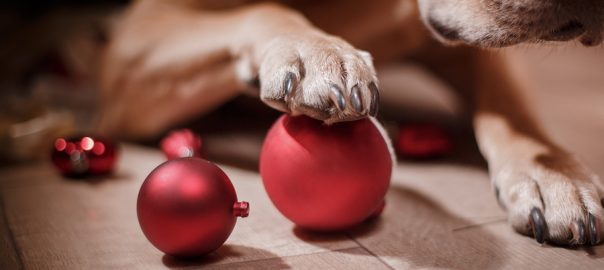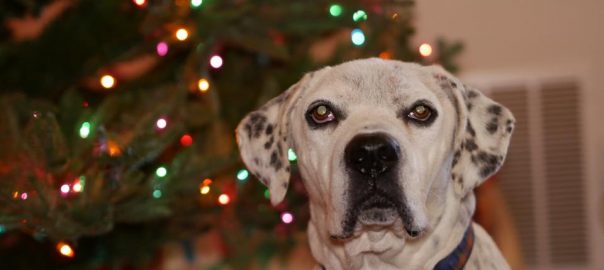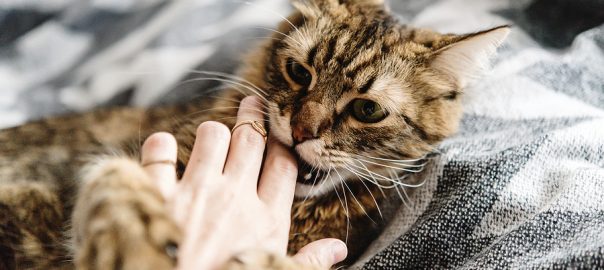
All posts by Dr. Marty Becker


What to do when your dog eats glass
Dogs probably don’t eat glass by choice, but when it’s in the form of a ball, as it is with many Christmas ornaments, dogs may not be able to resist. What should you do if they ingest glass? That was the question a reader asked; here’s what I had to say.
Q: My friend’s American Eskimo dog bit down on a glass Christmas ornament and swallowed some of the pieces. Should she have induced vomiting?
A: Dogs are equal-opportunity eaters. If it smells or even looks edible, they won’t hesitate to ingest it. I never cease to be amazed at the things dogs will put in their mouths and chomp down on. That includes glass ornaments and lightbulbs.
The real surprise is that biting down on a glass ornament is typically less dangerous for dogs than it might seem. Most often, dogs appear to realize they’ve made a mistake and don’t swallow the shards. They still run the risk of cutting their tongue or lip, of course, with the resultant bleeding. If it’s severe enough, the dog may need a trip to the veterinarian for treatment.
When dogs do swallow the pieces, your veterinarian may feel it’s safer to let the glass pass naturally instead of trying to bring it back up by inducing vomiting. I have heard of people who have induced vomiting in cases like this, but we usually don’t recommend it. The dog runs a greater risk of injury bringing back up sharp items such as glass or needles.
If you know that your dog has swallowed something dangerous such as glass, call your veterinarian immediately for advice. If your dog isn’t showing signs of choking — gagging or pawing at the throat, for instance — your veterinarian may suggest giving bread, pumpkin or mashed potatoes to help encase the glass as it passes through the intestinal tract. Any signs such as straining to defecate, lethargy, blood in the stool, lack of appetite or abdominal pain call for an immediate trip to the veterinarian. These signs may indicate a blockage or damage to the intestinal tract that requires surgical repair.
Read more, including alternatives to feline declawing, in this week’s Pet Connection.

Help create more angels to save pets in need
Our family has had more than its share of sick pets this year. Maybe yours has, too. And I can’t imagine dealing with the struggle to save them, and the pain of letting them go, without the rock-solid support and skill of the veterinary technicians who have cared for them (and us).
When we lost our beloved Quin’C earlier this year, we chose to honor his memory by establishing a scholarship for veterinary technician students who would be dedicated to helping homeless pets like Quin’C, and to easing the fear, anxiety, and stress experienced by millions of pets every day.
These students will receive free training and certification in preventing and treating that fear, anxiety, and stress from Fear Free, and Teresa and I started the scholarship off with a $1,000 donation, joined by many of you who wanted to remember our boy.
Now we turn to you again, as the year comes to an end, to ask that you again support these wonderful students who want nothing more than to help animals. Your support can mean the difference between one more dedicated, skilled veterinary technician… or one less.
In the memory and name of every pet who has ever received care from one of these angels, please donate to the Quin’C Memorial Fund today.
Bless you and may your holidays and the coming year be full of love, joy, and health for you and everyone you love!
The Becker Family
PS: You can learn more about the Quin’C Scholarship and other ways to donate here.

When your cat starts making those unwanted ‘wake up calls’
Has your started waking you up early and often? That was the problem faced by a reader, and I teamed up with my daughter, trainer Mikkel Becker, to respond.
Q: Our 11-year-old male cat has some new behaviors. He used to sleep at the foot of our bed, but now he cuddles, purrs and sleeps with me. At about 4 a.m., he starts walking around the bed, meowing and nibbling on my fingers and chewing on my husband’s hair. If we shut him out of our room, he cries and paws at the door relentlessly. I don’t mind having him in the room until the nibbling and meowing start. Is the nibbling an alpha behavior?
A: It’s great that your cat is so affectionate, but I can certainly see how the early-morning attention could get old — fast! The nibbling isn’t alpha behavior, because that’s not a concept that applies to cats (or to dogs, for that matter). Your cat does want your attention, whether it’s because he wants to eat breakfast — now! — or because to him it seems like a good time for some interaction.
The other possibility is that his behavior is changing because he is showing early signs of dementia.
As with any change in behavior, we recommend taking your cat in for a veterinary exam to rule out underlying health problems. Sometimes being obnoxious is the only way cats have to tell us that they’re not feeling well.
If your cat gets a clean bill of health, he may simply be ready for breakfast at that time of the morning. Cats are crepuscular, meaning they are most active at dawn and dusk. Your cat’s body clock may be telling him that it’s time to eat. To ensure uninterrupted sleep for yourself, try purchasing a feeder with a timer. You can set it to go off just before the time your cat normally wakes you. If you feed canned food, look for a feeder with an ice pack to keep food chilled.
Read more, including the top 10 reasons to take your pet to the ER vet, in this week’s Pet Connection!

Survey: What would you like to know about your pets?
I recently surveyed the subscribers to my mailing list about what kind of information they most wanted me to write about. Now I’m working with our Fear Free Happy Homes website to create all kinds of resources to give you the information you actually want… in the form of classes, videos, interactive games, connection with veterinarians and other experts — pretty much anything you can imagine, we’ll consider!
If you could take just a few minutes to respond to two short questions, I’d be very grateful. And so will the pets and people who will benefit from these resources.
Thank you, friends!